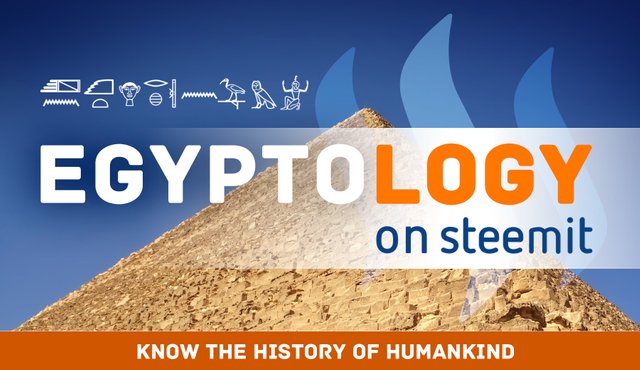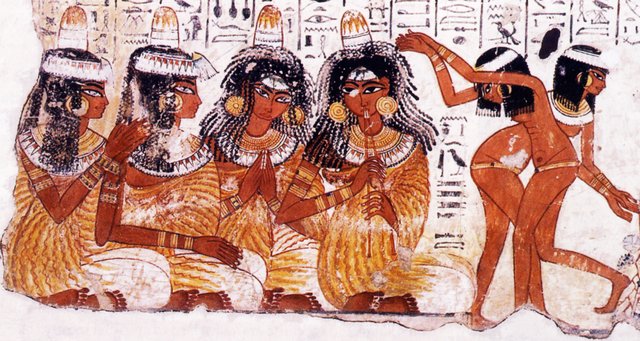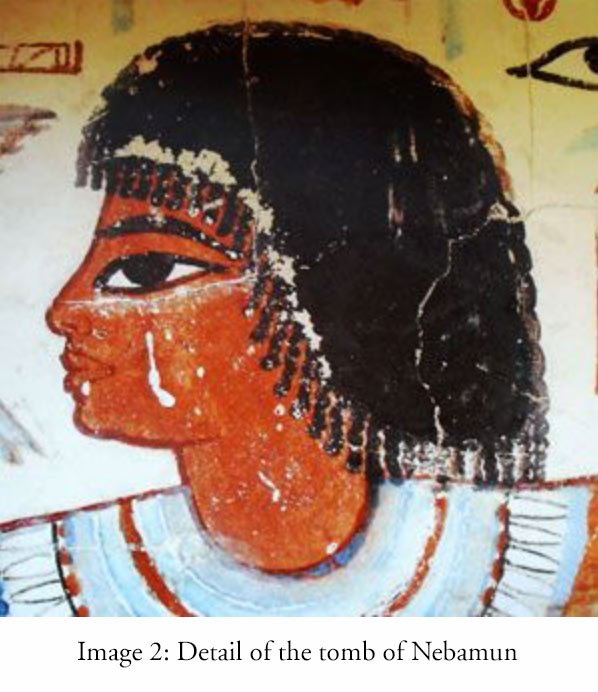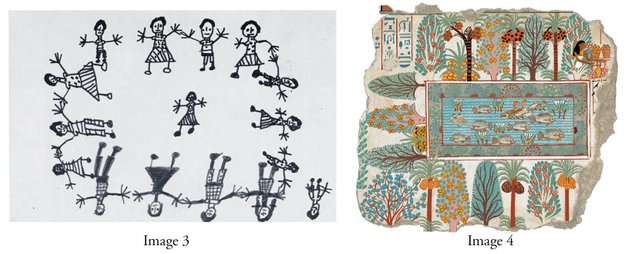Misconceptions in Egyptology
Introduction
The Ancient Egyptian way of drawing is quite unique to the modern perception: the characteristic depiction of Gods and other protagonists in ritual scenes on temple- and tomb walls are very well known to us and has lead to different interpretations. The song „Walk like an Egyptian“ by The Bangles is just one of the contemporary dealings with that special style of the Ancient Egyptian art.
This typical pose is a result of an artistic phenomenon called „aspective“ – in contrast to the common known „perspective“. The last is used to draw two dimensions to get a clue of a threedimensionsional object. The aspective drawing means in simplified terms, that only certain aspects of an object are depicted, selected by the artist, depending on his/her view, whats important or not.
For the Ancient Egyptian art the eyes for instance were more essential then the mouth. That’s why the eye was drawn in frontal view while the head itself was shown in profile view.
A new term derived from some „politically incorrect“ conclusions
The new german term „Aspektive“ was shaped around 1974 by the famous german Egyptologist Emma Brunner-Traut (1911–2008). In her – both celebrated and controversial discussed – book „Frühformen des Erkennens“ (english: Early Forms of Recognition) she was the first who connected Ancient Egyptian art with scientific brain research and came to the conclusion, that the way ancient cultures depicted their everyday life and religious believes, was a result of a „not yet developed“ ability of the brain to reproduce threedimensional objects on a flat medium. In this context she stated, that one could compare the mental state of ancient cultures (Egyptian, Sumerians, Akkadians, Phoenicians and so on) with „mental patients“, „children in their early stage of learning to draw“ or the so called „sunday painters“, which are drawing in non-professional, naive way. (Brunner-Traut 1996, 4; 7ff.) That modern cultures now can draw threedimenional objects could have been caused by an evolutional „change in cognitive-psychic perception" how to gain the shape and nature of an object. (Brunner-Traut 1996, 12). The Ancient Egyptian, so this researcher was convinced, painted what he wanted to be seen, not what was really visible from a certain perspective. The complete object had to be applied to the wall, while a perspective drawn object would naturally hide some parts.
Children and mental patients
After Brunner-Traut (1996, 59) the childish painting is a successive documentation of the process of gaining knowledge and thinking. She stated, that this ability is available to the child in a very early stage, but the ability for perspective drawing must be learned through long and hard exercising.
But what’s even more interesting: a list was published 1962 by the psychiatrist Helmut Rennert, that Brunner-Traut used as a reference for describing the egyptian „state of mind“: Amongst other things Rennert found out, that mentally ill people (including shizophrenics, neurotics and also drug addicts with brain damages):
- have a lack of perspective in their drawings
- tend to combine human and animal body parts
- have an emphasized interest on the „eye“ (of humans/animals)
(see reference in: Brunner-Traut 1996, 63f.).
The misconception: something important was not considered!
The given example from that child’s drawing might be comparable with the drawings of the egyptians. But especially the coincidence with Rennert's list is intriguing. So Brunner-Trauts conclusions are not surprising.
But we are talking here about a culture that was not just „creative“ in decorating their tombs and temples, acting like children that are discovering their world around them or like shizophrenic patients with a perceptual disorder. They used pictures mainly for magical purposes! Much has been already written about the ancient mythology, the religious beliefs and performed rituals (see Assmann 2002). As we now know, not a single object was drawn randomly on a wall. Also it was not just an artistic approach! (Almost) every piece of a composition was part of a complex system of magical actions. The aesthetic in drawings were guided by Ma’at – the principle of order in contrast to chaos. They never painted their walls with things they wanted to avoid! No failure or drama is shown on that theater-like stages where the Ancient Egyptians were buried.
So, the aspective drawing is a natural consequence of the desire to show what they wanted to be existent in eternity. That’s why we see things on their their creative compositions that you can’t percept normally by just looking at an object. The Ancient Egyptians projected their wishes to walls, stelae and other mediums in a very conscious way. To be working properly a magical act required a precise fixing of the information on a medium (see as an example: von Lieven 2002, 56). This is one of the main reasons of the „aspective“ paintings. The „eye“ meant safety and protection (Müller-Winkler 1986) - so it had to be shown completely. A „half“ eye – like in a perspective drawing – would cause the loss of safety and protection in the afterlife: a terrible idea for the Ancient Egyptians.
Summary and conclusion
The idea of an „early stage“ in development of mental abilities was of course a „hot iron“ Brunner-Traut touched (see quote above). She was clear about it when she published her research. She knew that her opinion would cause a yelp in the scientific world.
The theories of Brunner-Traut could be proven wrong by extending the research to the basic philosophy of the Ancient Egyptians. Drawings of mixed human-animal deities for example were expressions of their religious conviction, that every part had a special power and in that combination the power would be more effective.
But while Brunner-Trauts ideas can be called „political incorrect“ today, she presented her research in a very guardedly way and never left a doubt about her appreciation to the cultural heritage she was writing about. She honored and respected the Ancient Egyptians. So she is a best-practice example for courageous scientific research. She was brave enough to discover unknown territory and paved the path for further interdisciplinary research. This was something that the academic compartment of Egyptology must learn: to come along with other disciplines, modern approaches and even controversial ideas. To understand past cultures in their entirety we must not only look at objects that we pull out of the sands. We have to work together with life sciences, anthropologists, experts of cognitive psychology and so on. All this will sharpen the lense for our perspective on the motives of our ancestors. Maybe one day we must completely correct our view on the Ancient Egyptians, who might be more advanced than we imagine right now. Who knows…
Bibliography
• Assmann, Jan (ed.), Ägyptische Mysterien?, Munich 2002.
• Brunner-Traut, Emma, Aspektive und die historische Wandlung der Wahrnehmungsweise, Stuttgart 1974.
• Brunner-Traut, Emma, Frühformen des Erkennens: Aspektive im Alten Ägypten, Darmstadt 1996 (3rd edition).
• Rennert, Helmut, Die Merkmale schizophrener Bildnerei, Jena 1962. (cited after Brunner-Traut 1996, 63 f.)
• von Lieven, Alexandra, Kosmographie und Priesterwissenschaft, in: Assmann, Jan (ed.), Ägyptische Mysterien?, Munich 2002, 47–58.
• Müller-Winkler, Claudia, in: Lexikon der Ägyptologie VI, Wiesbaden 1986, Sp. 824–826, s.v. Udjat-Auge.
Images Sources
Image 1: Source
Image 2: Source
Image 3: Scan of Brunner-Traut, Emma, Frühformen des Erkennens: Aspektive im Alten Ägypten, Darmstadt 1996 (3rd edition), image 36, page 45.
Image 4: Source




Interesting that they couldn't draw 3 dimensional objects and yet physically built the largest 3 dimensional structures on earth. I think we know very little of ancient people because we always look back through the lens of materialism , when ancient people seem to of existed in a differing state on consciousness. Its very arrogant to believe that they were childlike and not as advanced as us just because they hadnt mastered materialism as much. We are the children when it comes to consciousness and understanding the non physical aspects to existence.
"We are the children when it comes to consciousness and understanding the non physical aspects to existence."
I agree.
Like a child I am sometimes in awe when I look, listen, observe, interpret the vast variety of explanations about the human psyche and achievements. I believe that even understanding the physical existence I only scratched the surface - from what I think I cannot separate the physical from the mental realm, the two are linked together and effect one another in a way, it astounds me.
Do you know the work of Alan Watts? He often talks of how a child is "as close to god" as we ever get. I don't believe he is referring to a religious version of God but a metaphysical interaction with the creative aspect of the Universe. A child see's wonder in everything because their brain is in balance, both the carnal side and divine side working in equilibrium. As a society we soon train them out of that way of looking at things and direct them into a physical, material way of interpreting whats around them, we kill off the inner child and then wonder why so many adults have a deep feeling of dissatisfaction. Getting back to the point, I believe ancient people and even some modern indigenous peoples have kept a much better balance in their brain architecture right into adulthood and so far from being inferior to modern mankind they are actually superior in interacting and interpreting the non-physical aspects of existence. This is why "mythology" seems so random and confusing to us and we dismiss it as quaint stories. Mythology and ancient religion deal with a mind before matter model, using personification as a vehicle to explain consciousness and we do it the injustice of taking it literally and then arrogantly dismissing it as nonsense.
Yes, I listened to Alan Watts over and over again. I love his eloquent art of talking and his unusual way of taking a matter and turn it into something I have never thought of.
In one of his lectures he asked children what a "thing" is and the kids started to describe things in using their characteristics like "a thing is round or square etc." - but one girl said a thing is a "Noun". He felt quite impressed by that observation and referred to it by saying that "a thing" comes from "thinking" and "naming" it. Names are Nouns and therefor we get a notion of things in the way we think of them.
I made the experience with my son and other kids that they stopp going deeper into the matter once they got a name for it. Like looking at a tree asking "what's that"? and being answered it is an "oak". In many occasions that was enough of an explanation and walking through a park with other kids they told one another: "look, that's an oak!" and the other kid replied: "I know. And that is a beech tree!" - I felt that is the condition you talk about, when schooling puts names into the brains of our children and that is that.
It neglects what a tree can be, the variety of meaning it can gain.
So a tree for me is a living being, hosting ever so many other living beings, casting shade to humans, impresses painters, accompanies his tree fellows, protects plants from direct sun light, dies eventually and gives food to the soil, insects and all kinds of creatures. Just by using the given name of a certain tree, does not give this profound insight in our surroundings.
Mythology is for me a very good way to connect with my inner realm, for it touches something I otherwise cannot get hold on. The work of C. G. Jung presents a good deal of mythological aspects. After listening to a recording on youtube I remembered a dream of mine and got in touch with what I experienced and should take care of. But it is not easy to connect with it. Guess it is just no habit to take mythology serious.
Excellent points. Yes the naming of something and the thinking in "words" is to me part of "living in the echo" as Watts so eloquently puts it. (have you read Alphabet Vs the Goddess by L. Shlain?)
I believe there is another aspect to this though, the material Tree that you describe is still illusionary. We use the word "tree", Nature/God uses a physical tree but both are essentially creating a symbol to understand consciousness in the material realm we occupy.
If energy and information combine to form matter, we have dual aspects of non-material combining to create symbols built in matter. This essentially is the dual aspects conveyed in all ancient belief systems. For instance the holy Trinity which i'm sure you know is Egyptian and maybe even older conveys Osiris as Information, Isis as Energy and the result of their union the physical manifestation of their offspring Horus. Jesus is the same personification of this concept.
Understanding ancient mythology as a science of consciousness , using personifications to explain the non-physical realm into the physical is the reason Jung and other great thinkers studied them in depth. Only a fool would dismiss ancient beliefs as mere bed time stories.
Good to have a dialogue with you.
I haven't known that Trinity is related to the Egyptians but I can follow easily your assumption it is even older. Why not? Many of our knowledge and beliefs can be followed far in history of mankind. The different interpretations resonate with us - with one more, with another one less.
What I always need is to integrate the insights into my daily life - and therefor into what "matters" with me. Without the connection to my physical existence I find it difficult to take in what I have learned or realized. I want to use wisdom - or whatever you may call it.
In almost every case I come to the point that mythology, psychology, sociology etc. for me only makes sense to dig into when what is stated can be connected to ethics. Ethics is an important Noun for me but even more significant is how I live them out in my relations to humans and all other living beings. Not easy.
May I ask for what and how you use your knowledge and insights? I really would like to know.
P.S. haven't read the book you mentioned.
An example of the Egyptian trinity
I agree, especially to the argument with the construction of the pyramids. Brunner-Traut mentioned this in her research, but she argued, that the shape of the pyramid was very simple and the Ancient Egyptian would never have been able to built complex halls and domes of metal and steel like we do today. But I think it needs more to build a structure like the pyramids in such a monumental way, than just a favor for toy building blocks. As we now know a deep mathematical understandin and physical knowledge was required.
But I want you to consider that we as egyptologists can only draw conclusions from the material heritage that we have access to. The rest is and stays speculation.
That's the trouble with these things there is far too much speculation stated as fact, that gets repeated. Its ok for "experts" in a field to not know things, the trouble is they always feel compelled to fill in the gaps in their knowledge with conjecture. Its very clear to an engineer that the mathematics and draughtsmanship needed to build any of these amazing structures is missing from the historical record. unfortunately there are some very closed minded people within Egyptology and this is holding us back from a true understanding of these wonderful artefacts.
This is indeed a true fact, but the reason for this lays in the history of Egyptology itself. It is (with other scientific subject) a very young and need to find a place in the academic world after the first "gold rush" when the excavators from all over the world rest without any documentation or publication. A lot of rumors and half-knowledge was used to build up secret societies. So, to keep the balance. It was a lot of Egyptologist. This led to an Egyptology that might be perceived as "stubborn".
No, not really. As far as I can see, Egyptology is in a transformational process. Especially young Egyptologists are more open minded than most of the people would imagine. The problem is just the academic boundaries in general (also in other subjects and research fields). No one is really "free" to publish crazy hypotheses without weighing the risks of being dismissed by collegues.
But more courageous people are coming up, believe me...
Ok well you know more than me about this and sounds like there is reason for optimism. I hope moving forward in the beautiful subject of Egyptology their are more like you and less like Zahi "Gatekeeper" Hawass.
Hi @laylahsophia I find the question of aspect quite interesting and useful to see the Egyptian "perspective". I notice that the ancient Chinese paintings had no discenrible perspective and were always drawn flat.
In contrast, some modern artists believe that paintings should represent all perspectives at the same time. A recent video by David Hockney proposed that painting should be seen as time passing and therefore you could see all sides of an object at the same time, as if by walking by.
Interesting facts. Didn't know that ancient Chinese used the same "flat drawing". Thank you! 👍🏼
Really nice read. Amazing to stumble upon such content. Ancient Egypt theme produced so much great content in modern day scifi and literature that it seems it's a bottomless inspiration source.
This post recieved an upvote from minnowpond. If you would like to recieve upvotes from minnowpond on all your posts, simply FOLLOW @minnowpond
Congratulations @laylahsophia! You have completed some achievement on Steemit and have been rewarded with new badge(s) :
Click on any badge to view your own Board of Honor on SteemitBoard.
For more information about SteemitBoard, click here
If you no longer want to receive notifications, reply to this comment with the word
STOPThanks for sharing this knowledge with us, it was very interesting!
Thank you for this interesting article!
What caught my attention was the aspect that "composition was part of a complex system of magical actions."
When I transfer that thought into my daily life and try to remember where moments of my life got meaning, it occurs to me that it were occasions held ritually. A ritual can have magic power. The second ingredient is consent. The more people believe in that magical action the more real it becomes.
hmmm.. I will think more about this matter.
Congratulations! Your post has been curated by the @steemstem team and has been featured on SteemStem Distilled #1:
https://steemit.com/steemstem/@steemstem/introducing-steemstem-distilled-1
I really enjoyed your post.
Congratulations @laylahsophia! You have completed some achievement on Steemit and have been rewarded with new badge(s) :
Click on any badge to view your own Board of Honor on SteemitBoard.
For more information about SteemitBoard, click here
If you no longer want to receive notifications, reply to this comment with the word
STOP